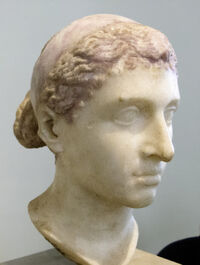Smithsonian Institution (Video game)
British Museum (Night at the Museum: Secret of the Tomb)
Cleopatra (Late 69 BC – August 12, 30 BC) was one of the most famous queens during Ancient Egypt and the last active pharaoh, only survived by her son, Caesarion as pharaoh.
Cleopatra didn't appear in the movies, but she was appeared in video game. Only her name is shown in the third film on an exhibit fact, but she does briefly appear in one of the blu-ray/dvd extras.
Appearances[]
Night at the Museum: Battle of the Smithsonian (The Video Game)[]
Cleopatra is encountered in the Night at the Museum: Battle of the Smithsonian video game after the player controls the two Anubis statues to finish the Anubis column game. Cleopatra begins taunting Larry Daley about the requirements for the tribute. Octavius and Larry began introducing themselves to her. Cleopatra gives the player a quest for them to complete. The player must retrieve a diamond for her found in the icy area. If the player gives it to her, they will complete the quest.
The player can also buy a rotation of Cleopatra in the store as an extra.
Night at the Museum: Secret of the Tomb[]
Cleopatra's name is shown on an exhibit sign when Larry and the gang are visiting Akhmenrah's mother and father in British Museum, but she did not appear in the movie. However, she does briefly appear on one of the Blu-Ray Extras: "The Home of History: Behind the Scenes at The British Museum". In that video are scenes of Larry and the gang meeting Cleopatra. So the scenes were acted and shot, but it is unknown why it was omitted from the film, why it does not appear as one of the deleted/extended scenes on the Blu-Ray disc, or who the actress was who played her.
Real-Life[]
Cleopatra VII Philopator (Greek: Κλεοπάτρα Φιλοπάτωρ; 69 BC – 10 August 30 BC) was queen of the Ptolemaic Kingdom of Egypt from 51 to 30 BC, and its last active ruler. A member of the Ptolemaic dynasty, she was a descendant of its founder Ptolemy I Soter, a Macedonian Greek general and companion of Alexander the Great.[note 6] After the death of Cleopatra, Egypt became a province of the Roman Empire, marking the end of the second to last Hellenistic state and the age that had lasted since the reign of Alexander (336–323 BC). Her native language was Koine Greek, and she was the only Ptolemaic ruler to learn the Egyptian language.
In 58 BC, Cleopatra presumably accompanied her father, Ptolemy XII Auletes, during his exile to Rome after a revolt in Egypt (a Roman client state) allowing his daughter Berenice IV to claim the throne. Berenice was killed in 55 BC when Ptolemy returned to Egypt with Roman military assistance. When he died in 51 BC, the joint reign of Cleopatra and her brother Ptolemy XIII began, but a falling-out between them led to open civil war. After losing the 48 BC Battle of Pharsalus in Greece against his rival Julius Caesar (a Roman dictator and consul) in Caesar's Civil War, the Roman statesman Pompey fled to Egypt. Pompey had been a political ally of Ptolemy XII, but Ptolemy XIII, at the urging of his court eunuchs, had Pompey ambushed and killed before Caesar arrived and occupied Alexandria. Caesar then attempted to reconcile the rival Ptolemaic siblings, but Ptolemy's chief adviser, Potheinos, viewed Caesar's terms as favoring Cleopatra, so his forces besieged her and Caesar at the palace. Shortly after the siege was lifted by reinforcements, Ptolemy XIII died in the 47 BC Battle of the Nile; Cleopatra's half-sister Arsinoe IV was eventually exiled to Ephesus for her role in carrying out the siege. Caesar declared Cleopatra and her brother Ptolemy XIV joint rulers but maintained a private affair with Cleopatra that produced a son, Caesarion. Cleopatra traveled to Rome as a client queen in 46 and 44 BC, where she stayed at Caesar's villa. After the assassinations of Caesar and (on her orders) Ptolemy XIV in 44 BC, she named Caesarion co-ruler as Ptolemy XV.
In the Liberators' civil war of 43–42 BC, Cleopatra sided with the Roman Second Triumvirate formed by Caesar's grandnephew and heir Octavian, Mark Antony, and Marcus Aemilius Lepidus. After their meeting at Tarsos in 41 BC, the queen had an affair with Antony. He carried out the execution of Arsinoe at her request, and became increasingly reliant on Cleopatra for both funding and military aid during his invasions of the Parthian Empire and the Kingdom of Armenia. The Donations of Alexandria declared their children Alexander Helios, Cleopatra Selene II, and Ptolemy Philadelphus rulers over various erstwhile territories under Antony's triumviral authority. This event, their marriage, and Antony's divorce of Octavian's sister Octavia Minor led to the Final War of the Roman Republic. Octavian engaged in a war of propaganda, forced Antony's allies in the Roman Senate to flee Rome in 32 BC, and declared war on Cleopatra. After defeating Antony and Cleopatra's naval fleet at the 31 BC Battle of Actium, Octavian's forces invaded Egypt in 30 BC and defeated Antony, leading to Antony's suicide. When Cleopatra learned that Octavian planned to bring her to his Roman triumphal procession, she killed herself by poisoning, contrary to the popular belief that she was bitten by an asp.
Cleopatra's legacy survives in ancient and modern works of art. Roman historiography and Latin poetry produced a generally critical view of the queen that pervaded later Medieval and Renaissance literature. In the visual arts, her ancient depictions include Roman busts, paintings, and sculptures, cameo carvings and glass, Ptolemaic and Roman coinage, and reliefs. In Renaissance and Baroque art, she was the subject of many works including operas, paintings, poetry, sculptures, and theatrical dramas. She has become a pop culture icon of Egyptomania since the Victorian era, and in modern times, Cleopatra has appeared in the applied and fine arts, burlesque satire, Hollywood films, and brand images for commercial products.






